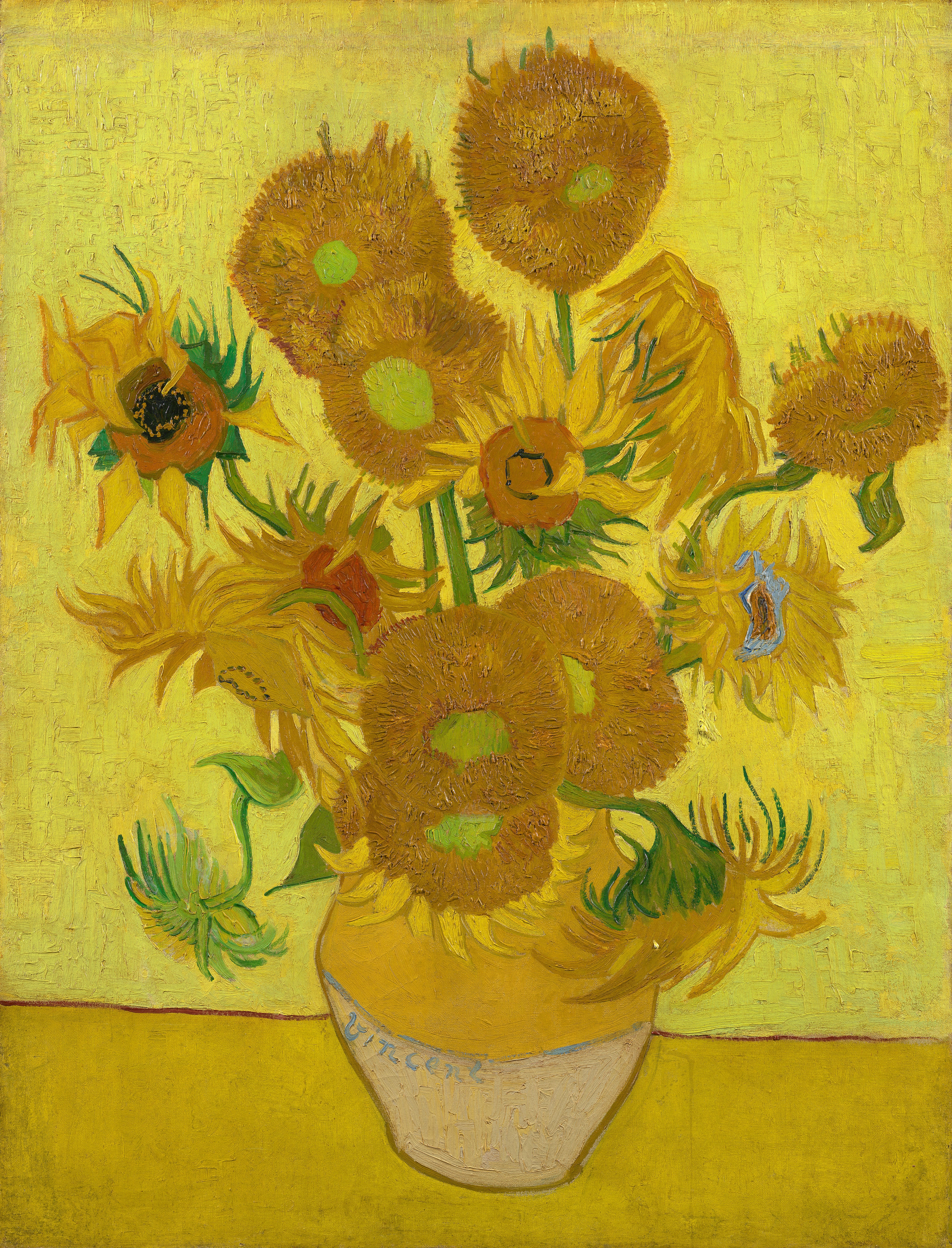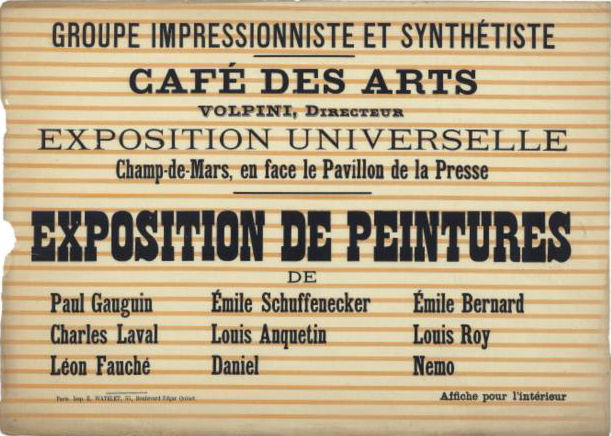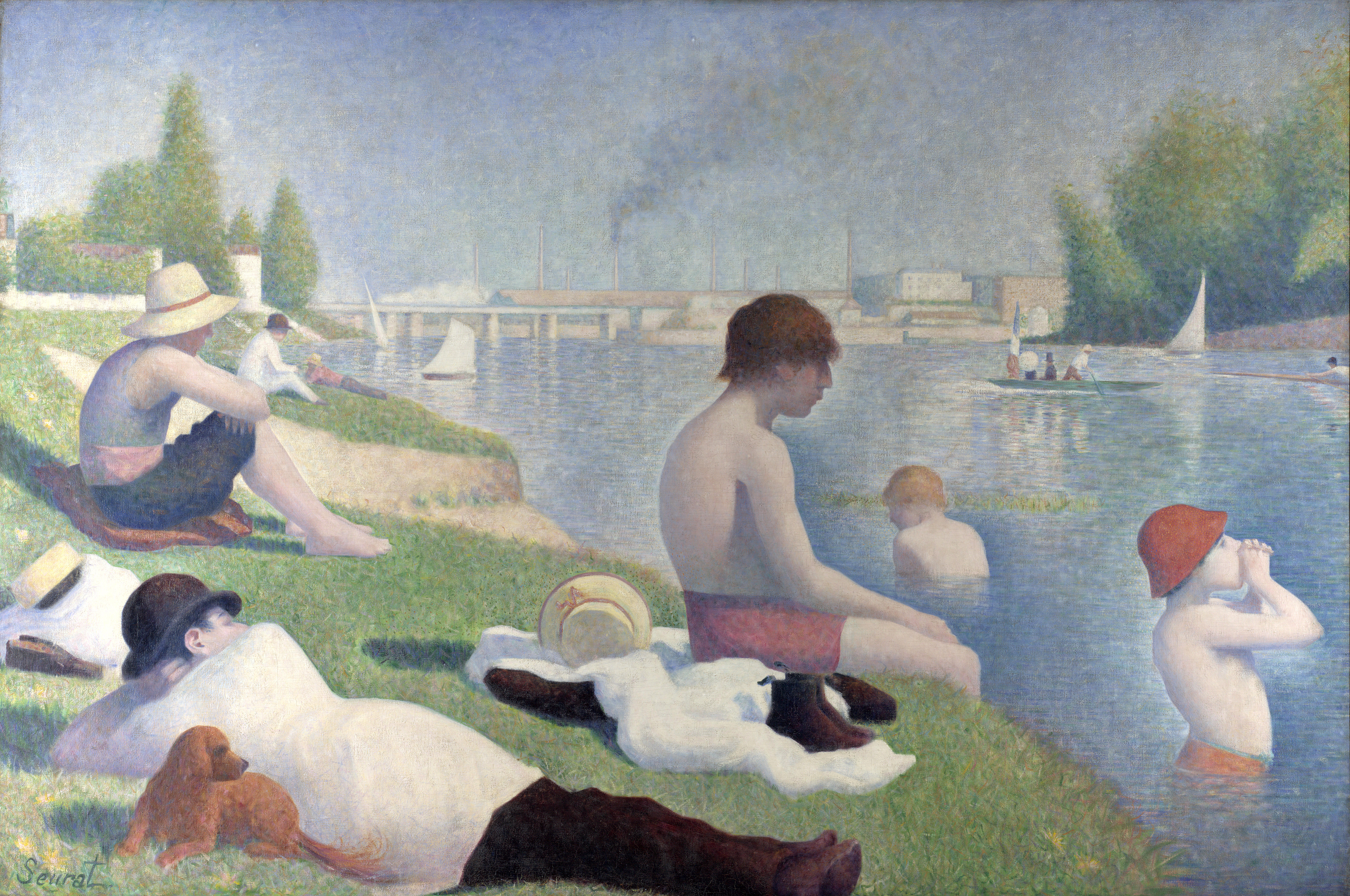|
Landscape At Auvers In The Rain
''Landscape at Auvers in the Rain'' is an oil painting on canvas by the Dutch Post-Impressionist painter Vincent van Gogh. Painted in July 1890, and completed just three days before his death, it depicts a landscape at Auvers-sur-Oise, where van Gogh spent the last years of his life. It is one of thirteen double-square canvases of landscapes around Auvers completed by van Gogh between 17 June and 27 July. The depiction of the rain with dark, diagonal lines is considered to be inspired by Japanese art, specifically the woodcuts of Hiroshige. It also displays the visceral relationship between nature and emotion that is a trademark of van Gogh's later work, as well as the stylistic innovations of a raised horizon line, expressive brushstrokes, and bold colours. This was one of Van Gogh's last paintings before his death and has been interpreted as symbolizing the cycle of human suffering contrasted with a sense of hope. The painting was bought by Gwendoline Davies in 1920 in Paris, a ... [...More Info...] [...Related Items...] OR: [Wikipedia] [Google] [Baidu] |
Vincent Van Gogh
Vincent Willem van Gogh (; 30 March 185329 July 1890) was a Dutch Post-Impressionist painter who posthumously became one of the most famous and influential figures in Western art history. In a decade, he created about 2,100 artworks, including around 860 oil paintings, most of which date from the last two years of his life. They include landscapes, still lifes, portraits and self-portraits, and are characterised by bold colours and dramatic, impulsive and expressive brushwork that contributed to the foundations of modern art. Not commercially successful, he struggled with severe depression and poverty, eventually leading to his suicide at age thirty-seven. Born into an upper-middle class family, Van Gogh drew as a child and was serious, quiet, and thoughtful. As a young man, he worked as an art dealer, often traveling, but became depressed after he was transferred to London. He turned to religion and spent time as a Protestant missionary in southern Belgium. He drif ... [...More Info...] [...Related Items...] OR: [Wikipedia] [Google] [Baidu] |
Post-Impressionist
Post-Impressionism (also spelled Postimpressionism) was a predominantly French art movement that developed roughly between 1886 and 1905, from the last Impressionist exhibition to the birth of Fauvism. Post-Impressionism emerged as a reaction against Impressionists' concern for the naturalistic depiction of light and colour. Its broad emphasis on abstract qualities or symbolic content means Post-Impressionism encompasses Les Nabis, Neo-Impressionism, Symbolism, Cloisonnism, the Pont-Aven School, and Synthetism, along with some later Impressionists' work. The movement's principal artists were Paul Cézanne (known as the father of Post-Impressionism), Paul Gauguin, Vincent van Gogh and Georges Seurat. The term Post-Impressionism was first used by art critic Roger Fry in 1906.Peter Morrin, Judith Zilczer, William C. Agee, ''The Advent of Modernism. Post-Impressionism and North American Art, 1900-1918'', High Museum of Art, 1986 Critic Frank Rutter in a review of the Salon d'Autom ... [...More Info...] [...Related Items...] OR: [Wikipedia] [Google] [Baidu] |
Sudden Shower Over Shin-Ōhashi Bridge And Atake
is a woodblock print in the ukiyo-e genre by the Japanese artist Hiroshige. It was published in 1857 as part of the series '' One Hundred Famous Views of Edo'' and is one his best known prints. ''One Hundred Famous Views of Edo'' The picture is part of the series '' One Hundred Famous Views of Edo'' which actually features 119 views of 'named places' or 'celebrated spots' in the area that is today Tokyo. The series was unique in being the first to feature this many separate landscape views. The series was produced between 1856 and 1859 with Hiroshige II finishing the series after the death of Hiroshige in 1858. This print was published in the ninth month of 1857. The series was commissioned shortly after the 1855 Edo earthquake and subsequent fires and featured many of the newly rebuilt or repaired buildings. The prints may have commemorated or helped draw Edo's citizens attention to the progress of the rebuilding. Description The print shows a small part of the wooden ''Sh ... [...More Info...] [...Related Items...] OR: [Wikipedia] [Google] [Baidu] |
Japonisme
''Japonisme'' is a French term that refers to the popularity and influence of Japanese art and design among a number of Western European artists in the nineteenth century following the forced reopening of foreign trade with Japan in 1858. Japonisme was first described by French art critic and collector Philippe Burty in 1872. While the effects of the trend were likely most pronounced in the visual arts, they extended to architecture, landscaping and gardening, and clothing. Even the performing arts were affected; Gilbert & Sullivan's '' The Mikado'' is perhaps the best example. From the 1860s, '' ukiyo-e,'' Japanese woodblock prints, became a source of inspiration for many Western artists. These prints were created for the commercial market in Japan. Although a percentage of prints were brought to the West through Dutch trade merchants, it was not until the 1860s that ukiyo-e prints gained popularity in Europe. Western artists were intrigued by the original use of color and ... [...More Info...] [...Related Items...] OR: [Wikipedia] [Google] [Baidu] |
Eugène Delacroix
Ferdinand Victor Eugène Delacroix ( , ; 26 April 1798 – 13 August 1863) was a French Romantic artist regarded from the outset of his career as the leader of the French Romantic school.Noon, Patrick, et al., ''Crossing the Channel: British and French Painting in the Age of Romanticism'', p. 58, Tate Publishing, 2003. In contrast to the Neoclassical perfectionism of his chief rival Ingres, Delacroix took for his inspiration the art of Rubens and painters of the Venetian Renaissance, with an attendant emphasis on colour and movement rather than clarity of outline and carefully modelled form. Dramatic and romantic content characterized the central themes of his maturity, and led him not to the classical models of Greek and Roman art, but to travel in North Africa, in search of the exotic. Friend and spiritual heir to Théodore Géricault, Delacroix was also inspired by Lord Byron, with whom he shared a strong identification with the "forces of the sublime", of nature in o ... [...More Info...] [...Related Items...] OR: [Wikipedia] [Google] [Baidu] |
Gauguin
Eugène Henri Paul Gauguin (, ; ; 7 June 1848 – 8 May 1903) was a French Post-Impressionist artist. Unappreciated until after his death, Gauguin is now recognized for his experimental use of colour and Synthetism, Synthetist style that were distinct from Impressionism. Toward the end of his life, he spent ten years in French Polynesia. The paintings from this time depict people or landscape painting, landscapes from that region. His work was influential on the French avant-garde and many modern artists, such as Pablo Picasso and Henri Matisse, and he is well known for his relationship with Vincent van Gogh, Vincent and Theo van Gogh (art dealer), Theo van Gogh. Gauguin's art became popular after his death, partially from the efforts of Art dealer, dealer Ambroise Vollard, who organized Art exhibition, exhibitions of his work late in his career and assisted in organizing two important posthumous exhibitions in Paris. Gauguin was an important figure in the Symbolism (arts), Sy ... [...More Info...] [...Related Items...] OR: [Wikipedia] [Google] [Baidu] |
Pointillist
Pointillism (, ) is a technique of painting in which small, distinct dots of color are applied in patterns to form an image. Georges Seurat and Paul Signac developed the technique in 1886, branching from Impressionism. The term "Pointillism" was coined by art critics in the late 1880s to ridicule the works of these artists, but is now used without its earlier pejorative connotation. The movement Seurat began with this technique is known as Neo-impressionism. The Divisionists used a similar technique of patterns to form images, though with larger cube-like brushstrokes. Technique The technique relies on the ability of the eye and mind of the viewer to blend the color spots into a fuller range of tones. It is related to Divisionism, a more technical variant of the method. Divisionism is concerned with color theory, whereas pointillism is more focused on the specific style of brushwork used to apply the paint. It is a technique with few serious practitioners today and is notably ... [...More Info...] [...Related Items...] OR: [Wikipedia] [Google] [Baidu] |
Seurat
Georges Pierre Seurat ( , , ; 2 December 1859 – 29 March 1891) was a French post-Impressionist artist. He devised the painting techniques known as chromoluminarism and pointillism and used conté crayon for drawings on paper with a rough surface. Seurat's artistic personality combined qualities that are usually thought of as opposed and incompatible: on the one hand, his extreme and delicate sensibility, on the other, a passion for logical abstraction and an almost mathematical precision of mind. His large-scale work ''A Sunday Afternoon on the Island of La Grande Jatte'' (1884–1886) altered the direction of modern art by initiating Neo-Impressionism, and is one of the icons of late 19th-century painting. Biography Family and education Seurat was born on 2 December 1859 in Paris, at 60 rue de Bondy (now rue René Boulanger). The Seurat family moved to 136 boulevard de Magenta (now 110 boulevard de Magenta) in 1862 or 1863.Seurat: p. 16 His father, Antoine Chrysostome Seu ... [...More Info...] [...Related Items...] OR: [Wikipedia] [Google] [Baidu] |
Pissarro
Jacob Abraham Camille Pissarro ( , ; 10 July 1830 – 13 November 1903) was a Danish-French Impressionist and Neo-Impressionist painter born on the island of St Thomas (now in the US Virgin Islands, but then in the Danish West Indies). His importance resides in his contributions to both Impressionism and Post-Impressionism. Pissarro studied from great forerunners, including Gustave Courbet and Jean-Baptiste-Camille Corot. He later studied and worked alongside Georges Seurat and Paul Signac when he took on the Neo-Impressionist style at the age of 54. In 1873 he helped establish a collective society of fifteen aspiring artists, becoming the "pivotal" figure in holding the group together and encouraging the other members. Art historian John Rewald called Pissarro the "dean of the Impressionist painters", not only because he was the oldest of the group, but also "by virtue of his wisdom and his balanced, kind, and warmhearted personality". Paul Cézanne said "he was a ... [...More Info...] [...Related Items...] OR: [Wikipedia] [Google] [Baidu] |
Monet
Oscar-Claude Monet (, , ; 14 November 1840 – 5 December 1926) was a French painter and founder of impressionist painting who is seen as a key precursor to modernism, especially in his attempts to paint nature as he perceived it. During his long career, he was the most consistent and prolific practitioner of impressionism's philosophy of expressing one's perceptions before nature, especially as applied to '' plein air'' (outdoor) landscape painting. The term "Impressionism" is derived from the title of his painting '' Impression, soleil levant'', exhibited in the 1874 ("exhibition of rejects") initiated by Monet and his associates as an alternative to the Salon. Monet was raised in Le Havre, Normandy, and became interested in the outdoors and drawing from an early age. Although his mother, Louise-Justine Aubrée Monet, supported his ambitions to be a painter, his father, Claude-Adolphe, disapproved and wanted him to pursue a career in business. He was very close to his mo ... [...More Info...] [...Related Items...] OR: [Wikipedia] [Google] [Baidu] |
Vincent Van Gogh - Brug In De Regen- Naar Hiroshige - Google Art Project
Vincent ( la, Vincentius) is a male given name derived from the Roman name Vincentius, which is derived from the Latin word (''to conquer''). People with the given name Artists * Vincent Apap (1909–2003), Maltese sculptor * Vincent van Gogh (1853–1890), Dutch Post-Impressionist painter *Vincent Munier (born 1976), French wildlife photographer Saints * Vincent of Saragossa (died 304), deacon and martyr, patron saint of Lisbon and Valencia * Vincent, Orontius, and Victor (died 305), martyrs who evangelized in the Pyrenees * Vincent of Digne (died 379), French bishop of Digne * Vincent of Lérins (died 445), Church father, Gallic author of early Christian writings * Vincent Madelgarius (died 677), Benedictine monk who established two monasteries in France * Vincent Ferrer (1350–1419), Valencian Dominican missionary and logician * Vincent de Paul (1581–1660), Catholic priest who served the poor * Vicente Liem de la Paz (Vincent Liem the Nguyen, 1732–1773), Vincent Duo ... [...More Info...] [...Related Items...] OR: [Wikipedia] [Google] [Baidu] |









